How Sustainable is the Increase in the Water Footprint of the Spanish Agricultural Sector? A Provincial Analysis between 1955 and 2005–2010
Abstract
:1. Introduction
2. Background and Literature Review
3. Methodology and Data
| Water scarcity levels (natural) | Low | Moderate | Significant | Severe |
| Thresholds for natural run-off | <20% | 20%–30% | 30%–40% | >40% |
| WSI levels (exploited degrees) | Slightly | Moderately | Heavily | Over (exploited) |
| Thresholds accounting for EWR | <30% | 30%–60% | 60%–100% | >100% |
4. Results
4.1. The Evolution of Provincial Water Footprints between 1955 and 2005
4.1.1. Blue and Green WFs Variations (Water Volumes)
| BWF 1955 (hm3) | BWF 2005–2010 average (hm3) | Change in BWF 1955 to 2005–2010 (hm3) | Share 1955 (%) | Share 2005–2010 average (%) | |
|---|---|---|---|---|---|
| Very Low Rainfall Provinces (x < 400 mm) | 1513 | 2088 | 575 | 15.6 | 14.6 |
| Low Rainfall Provinces (400 < x < 600 mm) | 5951 | 8687 | 2736 | 61.2 | 61.0 |
| Intermediate Rainfall Provinces (600 < x < 900 mm) | 1673 | 3027 | 1354 | 17.2 | 21.2 |
| High Rainfall Provinces (x > 900mm) | 586 | 450 | −136 | 6.0 | 3.2 |
| Spain | 9723 | 14,252 | 4529 | 100 | 100 |
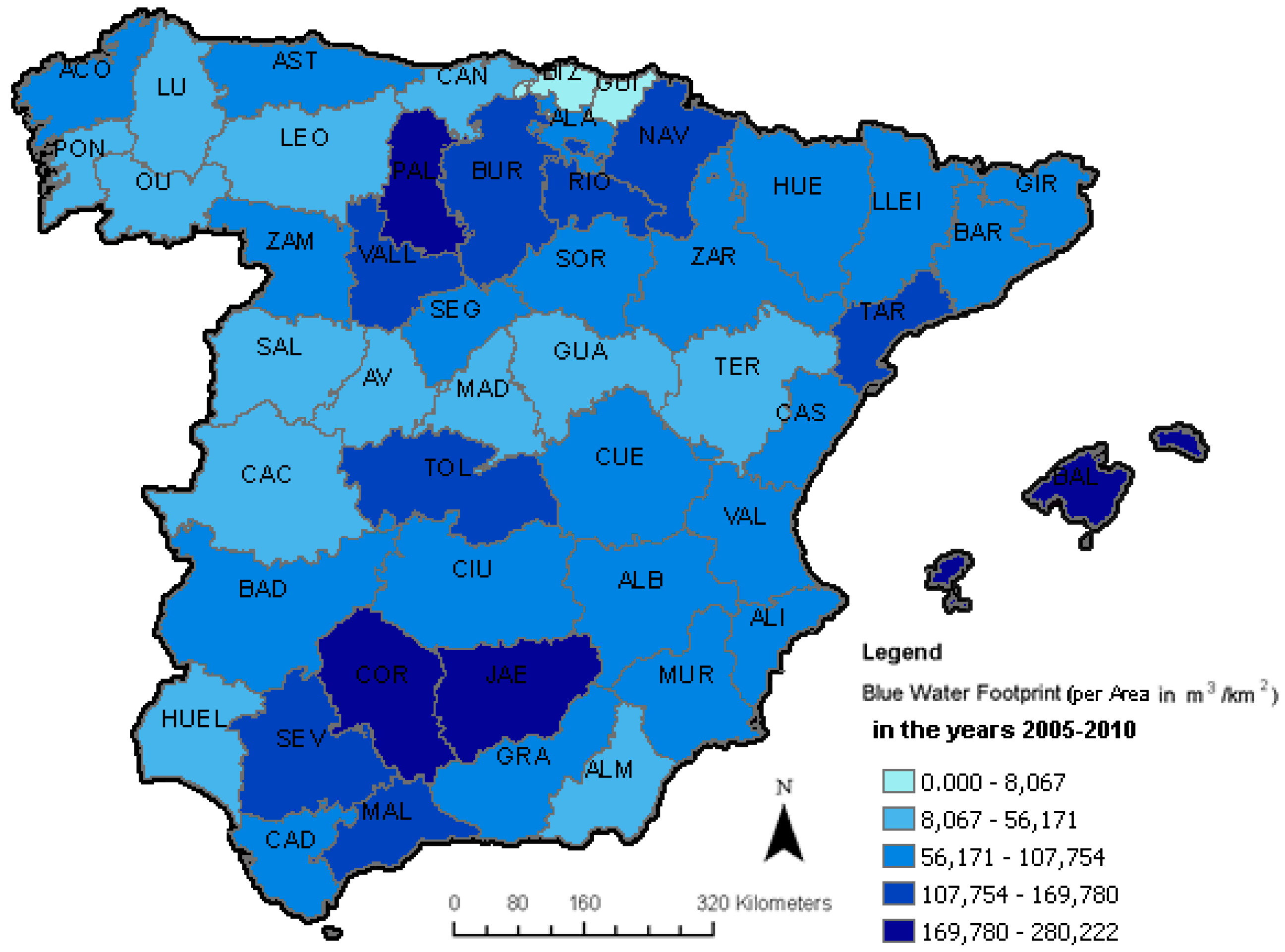
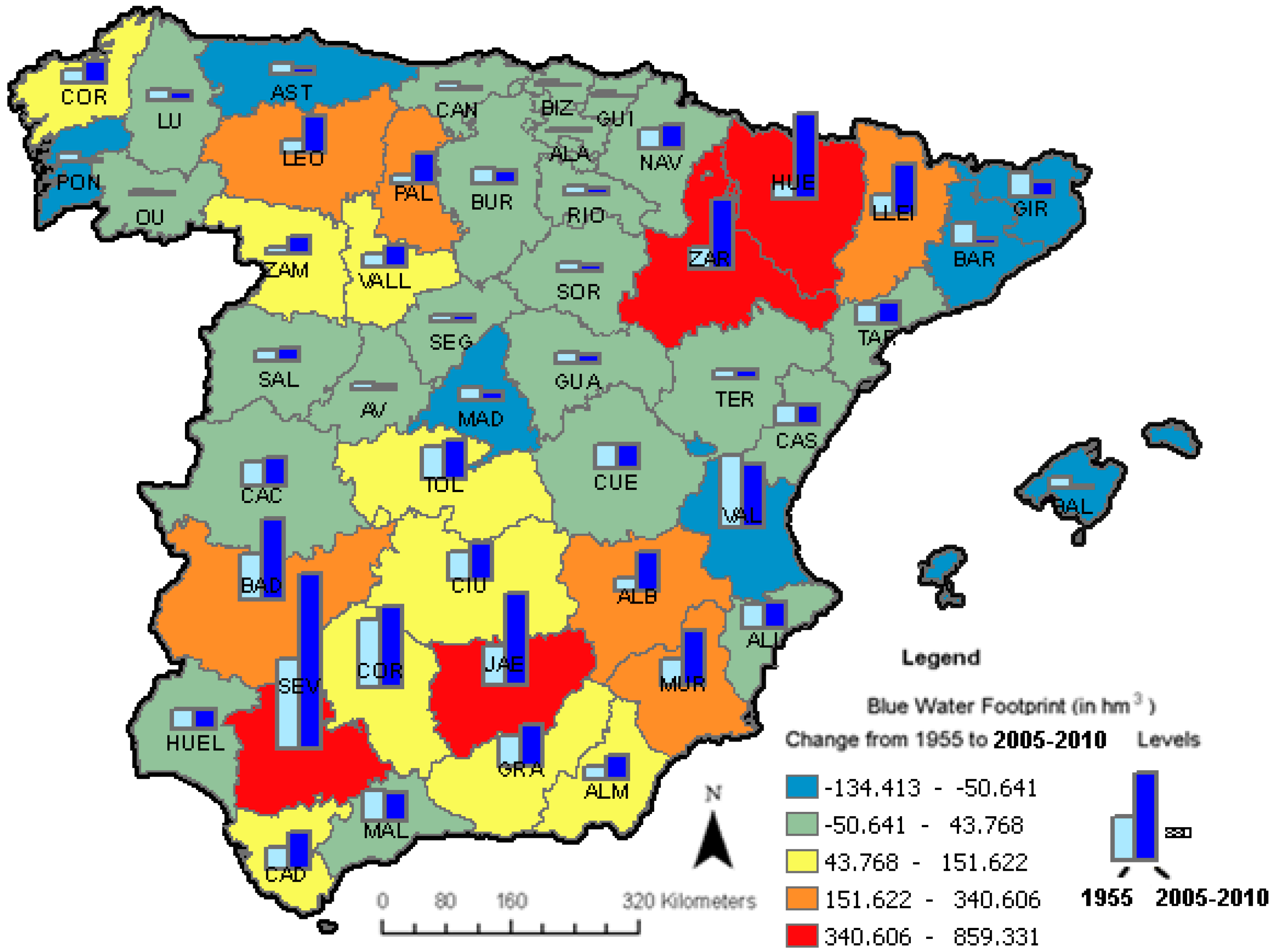
| GWF 1955 (hm3) | GWF 2005–2010 average (hm3) | Change in GWF 1955 to 2005–2010 average (hm3) | Share 1955 (%) | Share 2005–2010 average (%) | |
|---|---|---|---|---|---|
| Very Low Rainfall Provinces (x < 400 mm) | 3578 | 4558 | 980 | 7.7 | 9.6 |
| Low Rainfall Provinces (400 < x < 600 mm) | 25,718 | 28,728 | 3010 | 55.4 | 60.5 |
| Intermediate Rainfall Provinces (600 < x < 900 mm) | 10,079 | 11,907 | 1828 | 21.7 | 25.1 |
| High Rainfall Provinces (x > 900mm) | 7022 | 2323 | −4699 | 15.1 | 4.9 |
| Spain | 46,397 | 47,515 | 1118 | 100 | 100 |
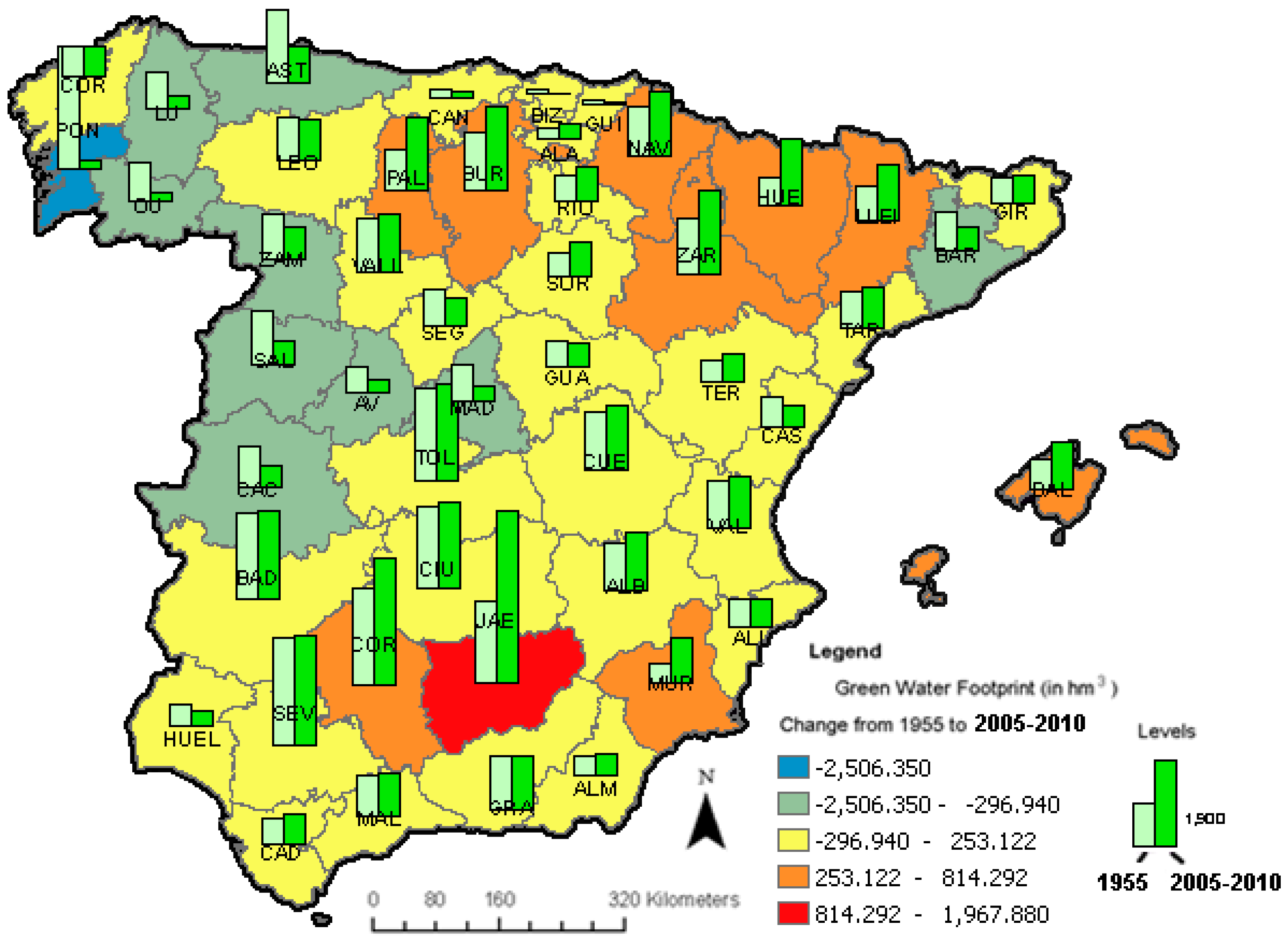
4.1.2. Changes of Agricultural Production Structure and Economic Benefits of the Increase in WFs between 1955 and 2005–2010
| 1955 | % | 2005–2010 | % | |
|---|---|---|---|---|
| Cereals | 70,296 | 25.8 | 150,018 | 22.2 |
| Industrial Crops | 18,340 | 6.7 | 72,813 | 10.8 |
| Fodder Crops | 27,025 | 9.9 | 28,385 | 4.2 |
| Fruit Trees | 39,752 | 14.6 | 123,602 | 18.3 |
| Horticultural products | 36,578 | 13.4 | 150,282 | 22.2 |
| Legumes | 13,573 | 5.0 | 6305 | 0.9 |
| Olives and olive oil | 19,518 | 7.2 | 90,180 | 13.3 |
| Tubers | 29,902 | 11.0 | 17,463 | 2.6 |
| Wine | 17,416 | 6.4 | 37,168 | 5.5 |
| Total | 272,400 | 100 | 676,215 | 100 |
| 1955 | % | Average 2005–2010 | % | |
|---|---|---|---|---|
| Very Low Rainfall Provinces (x < 400 mm) | 37,714 | 14 | 154,744 | 23 |
| Low Rainfall Provinces (400 < x < 600 mm) | 130,773 | 48 | 365,030 | 54 |
| Intermediate Rainfall Provinces (600 < x < 900 mm) | 59,911 | 22 | 136,504 | 20 |
| High Rainfall Provinces (x > 900 mm) | 44,002 | 16 | 20,737 | 3 |
| Spain | 272,400 | 100 | 677,015 | 100 |
4.2. Water Stress Indicators and Relation to Economic Variables
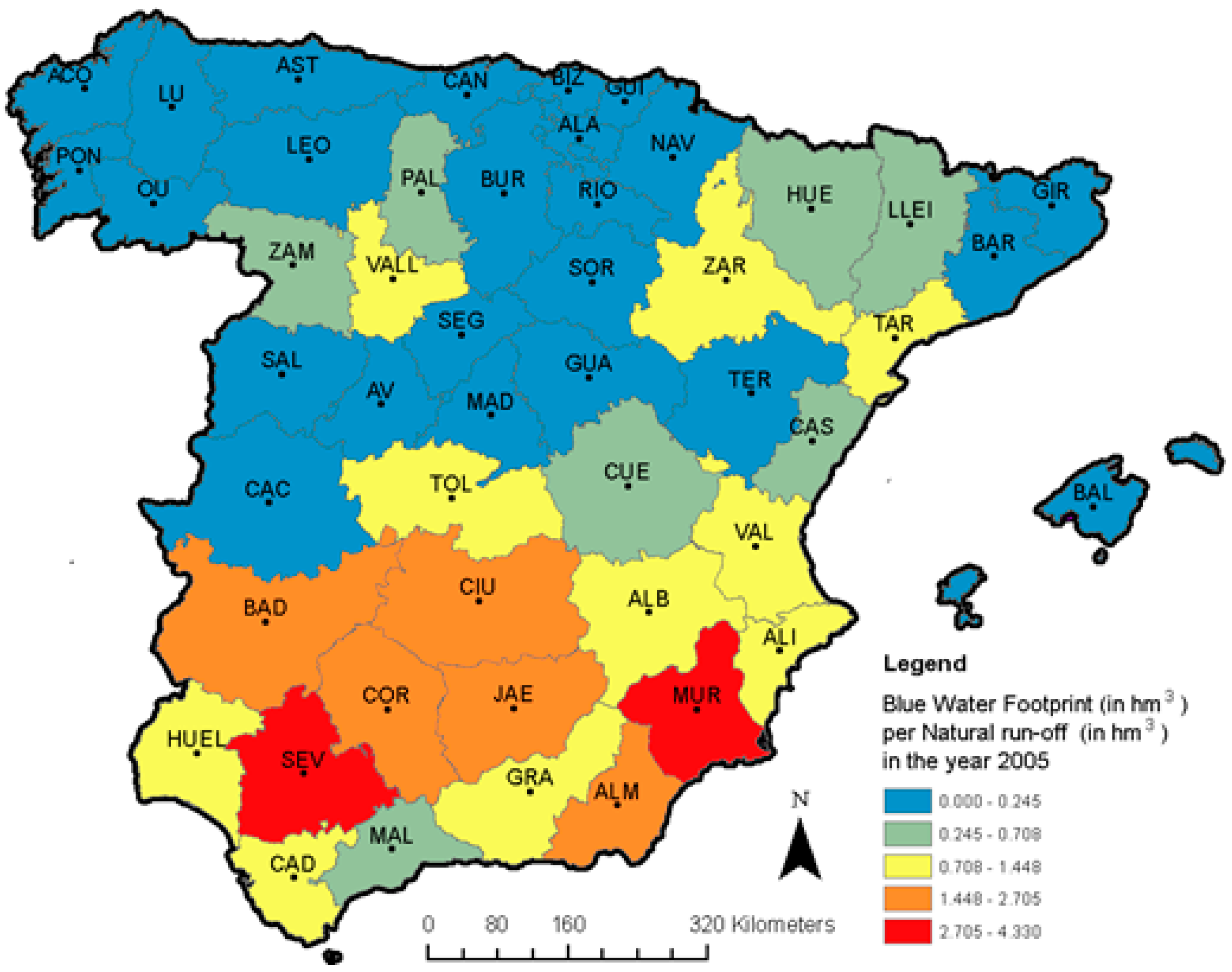
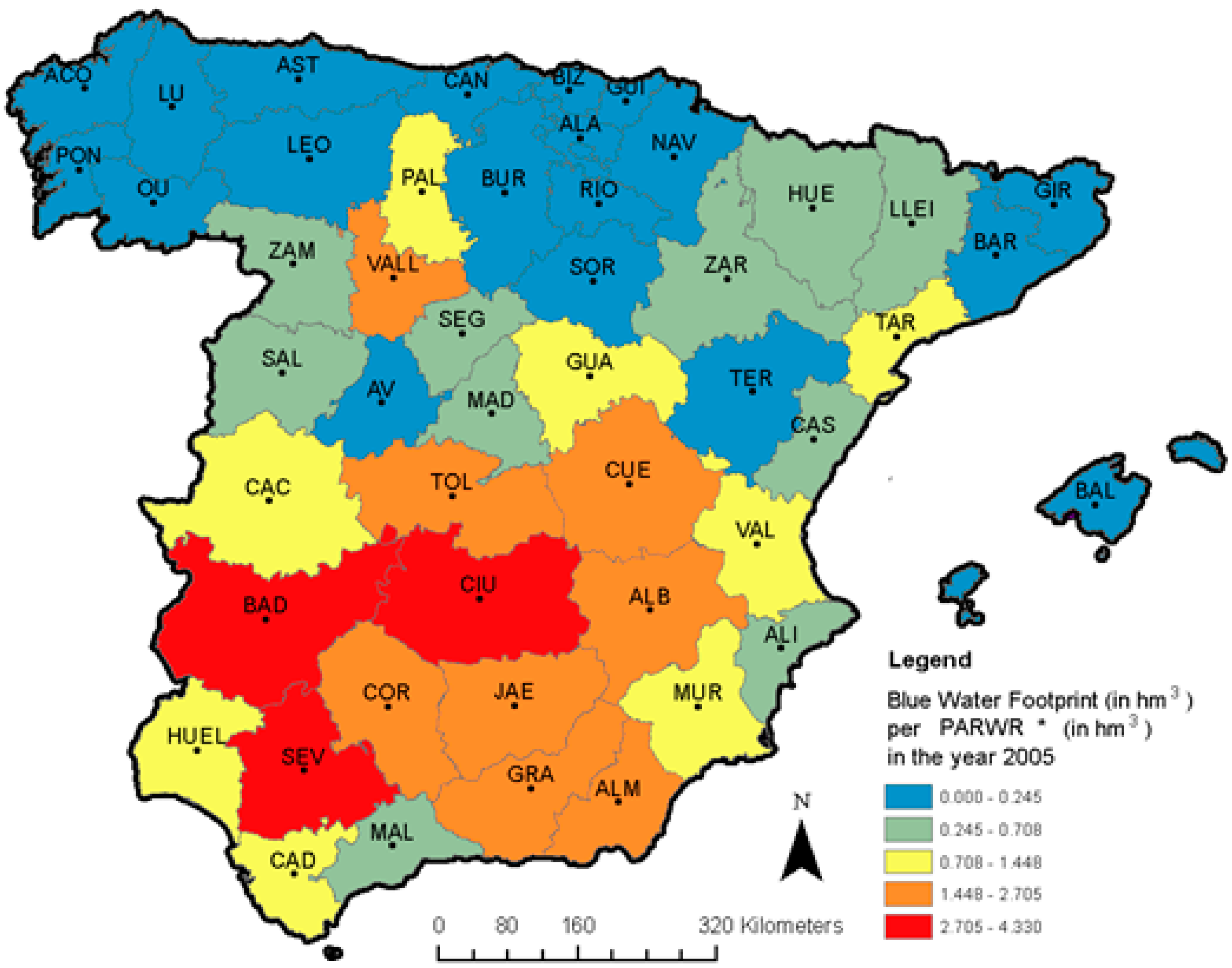
4.3. Economic Costs of the Increase in WFs between 1955 and 2005



5. Conclusions
Supplementary Materials
Acknowledgments
Author Contributions
Conflicts of Interest
References
- Cazcarro, I.; Duarte, R.; Martín-Retortillo, M.; Pinilla, V.; Serrano, A. Water scarcity and agricultural growth in Spain: From curse to blessing? In Natural Resources and Economic Growth: Learning from History, 1st ed.; Badía-Miró, M., Pinilla, V., Willebald, H., Eds.; Routledge: London, UK, 2015. [Google Scholar]
- Hoekstra, A.Y.; Hung, P.Q. Globalisation of water resources: International virtual water flows in relation to crop trade. Global Environ. Change 2005, 15, 45–56. [Google Scholar] [CrossRef]
- Hoekstra, A.Y.; Chapagain, A.K.; Aldaya, M.M.; Mekonnen, M.M. The Water Footprint Assessment Manual: Setting the Global Standard; Earthscan: London, UK, 2011. [Google Scholar]
- Chapagain, A.K.; Hoekstra, A.Y.; Savenije, H.H.G. Water saving through international trade of agricultural products. Hydrol. Earth Syst. Sci. 2006, 10, 455–468. [Google Scholar] [CrossRef]
- Hoekstra, A.Y.; Mekonnen, M.M. The water footprint of humanity. Proc. Natl. Acad. Sci. USA 2012, 109, 3232–3237. [Google Scholar] [CrossRef] [PubMed]
- Mekonnen, M.; Hoekstra, A.Y. The green, blue and grey water footprint of crops and derived crop products. Hydrol. Earth Syst. Sci. 2011, 15, 1577–1600. [Google Scholar] [CrossRef]
- Mekonnen, M.M.; Hoekstra, A.Y. A global assessment of the water footprint of farm animal products. Ecosystems 2012, 15, 401–415. [Google Scholar] [CrossRef]
- Chapagain, A.K.; Hoekstra, A.Y. The water footprint of coffee and tea consumption in the netherlands. Ecol. Econ. 2007, 64, 109–118. [Google Scholar] [CrossRef]
- Chapagain, A.K.; Hoekstra, A.Y.; Savenije, H.H.G.; Gautam, R. The water footprint of cotton consumption: An assessment of the impact of worldwide consumption of cotton products on the water resources in the cotton producing countries. Ecol. Econ. 2006, 60, 186–203. [Google Scholar] [CrossRef]
- Chapagain, A.K.; Orr, S. An improved water footprint methodology linking global consumption to local water resources: A case of spanish tomatoes. J. Environ. Manag. 2009, 90, 1219–1228. [Google Scholar] [CrossRef]
- Aldaya, M.M.; Hoekstra, A.Y. The water needed for italians to eat pasta and pizza. Agric. Syst. 2010, 103, 351–360. [Google Scholar] [CrossRef]
- Chouchane, H.; Hoekstra, A.Y.; Krol, M.S.; Mekonnen, M.M. The water footprint of tunisia from an economic perspective. Ecol. Indic. 2015, 52, 311–319. [Google Scholar] [CrossRef]
- Zhuo, L.; Mekonnen, M.M.; Hoekstra, A.Y. Sensitivity and uncertainty in crop water footprint accounting: A case study for the yellow river basin. Hydrol. Earth Syst. Sci. 2014, 18, 2219–2234. [Google Scholar] [CrossRef]
- Vanham, D.; Bidoglio, G. The water footprint of agricultural products in European river basins. Environ. Res. Let. 2014, 9. [Google Scholar] [CrossRef]
- Mekonnen, M.M.; Hoekstra, A.Y. Water conservation through trade: The case of Kenya. Water Int. 2014, 39, 451–468. [Google Scholar] [CrossRef]
- Zeng, Z.; Liu, J.; Koeneman, P.H.; Zarate, E.; Hoekstra, A.Y. Assessing water footprint at river basin level: A case study for the heihe river basin in northwest china. Hydrol. Earth Syst. Sci. 2012, 16, 2771–2781. [Google Scholar] [CrossRef]
- Dumont, A.; Salmoral, G.; Llamas, M.R. The water footprint of a river basin with a special focus on groundwater: The case of Guadalquivir basin (Spain). Water Resour. Ind. 2013, 1–2, 60–76. [Google Scholar] [CrossRef]
- Aldaya, M.M.; Llamas, M.R. Water Footprint Analysis for the Guadiana River Basin; UNESCO-IHE: Delft, The Netherlands, 2008; Volume 35. [Google Scholar]
- Aldaya, M.M.; Martínez-Santos, P.; Llamas, M.R. Incorporating the water footprint and virtual water into policy: Reflections from the Mancha Occidental region, Spain. Water Resour. Manag. 2010, 24, 941–958. [Google Scholar] [CrossRef]
- Garrido, A.; Llamas, M.R.; Novo, P.; Rodríguez-Casado, R.; Aldaya, M.M. Water Footprint and Virtual Water Trade in Spain: Policy Implications; Springer: New York, NY, USA, 2010. [Google Scholar]
- Duarte, R.; Pinilla, V.; Serrano, A. The water footprint of the Spanish agricultural sector: 1860–2010. Ecol. Econ. 2014, 108, 200–207. [Google Scholar] [CrossRef]
- Liu, J.; Sun, S.; Wu, P.; Wang, Y.; Zhao, X. Evaluation of crop production, trade, and consumption from the perspective of water resources: A case study of the Hetao irrigation district, China, for 1960–2010. Sci. Total Environ. 2015, 505, 1174–1181. [Google Scholar] [CrossRef] [PubMed]
- Zhao, C.; Chen, B.; Hayat, T.; Alsaedi, A.; Ahmad, B. Driving force analysis of water footprint change based on extended stirpat model: Evidence from the Chinese agricultural sector. Ecol. Indic. 2014, 47, 43–49. [Google Scholar] [CrossRef]
- Duarte, R.; Pinilla, V.; Serrano, A. The effect of globalisation on water consumption: A case study of the Spanish virtual water trade, 1849–1935. Ecol. Econ. 2014, 100, 96–105. [Google Scholar] [CrossRef]
- Duarte, R.; Pinilla, V.; Serrano, A. Globalization and natural resources: The expansion of the spanish agrifood trade and its impact on water consumption, 1965–2010. Reg. Environ. Change 2015, in press. [Google Scholar]
- Clar, E.; Pinilla, V.; Serrano, R. El comercio agroalimentario español en la segunda globalización, 1951–2011. Historia Agraria 2015, 63, 183–213. [Google Scholar]
- Baiardi, D.; Bianchi, C.; Lorenzini, E. Food competition in world markets: Some evidence from a panel data analysis of top exporting countries. J. Agric. Econ. 2014. [Google Scholar] [CrossRef]
- Vorosmarty, C.J. Global water resources: Vulnerability from climate change and population growth. Science 2000, 289, 284–288. [Google Scholar] [CrossRef] [PubMed]
- Oki, T.; Kanae, S. Global hydrological cycles and world water resources. Science 2006, 313, 1068–1072. [Google Scholar] [CrossRef] [PubMed]
- Raskin, P. Water Futures: Assessment of Long-Range Patterns and Problems; Stockholm Environment Institute: Stockholm, Sweden, 1997. [Google Scholar]
- Alcamo, J.; Henrichs, T.; Rösch, T. World Water in 2025: Global Modelling and Scenario Analysis for the World Commission on Water for the 21st Century; University of Kassel: Kassel, Germany, 2000. [Google Scholar]
- Alcamo, J.; Henrichs, T. Critical regions: A model-based estimation of world water resources sensitive to global changes. Aquatic Sci. 2002, 64, 352–362. [Google Scholar] [CrossRef]
- Lallana, C.; Marcuello, C. Water Exploitation Index; European Environmental Agency: Copenhagen, Denmark, 2004. [Google Scholar]
- Mekonnen, M.M.; Hoekstra, A.Y. Water footprint benchmarks for crop production: A first global assessment. Ecol. Indic. 2014, 46, 214–223. [Google Scholar] [CrossRef]
- Brown, A.; Matlock, M.D. A Review of Water Scarcity Indices and Methodologies; University of Arkansas, Sustainability Consortium: Fayetteville, AR, USA, 2011. [Google Scholar]
- Falkenmark, M. The massive water scarcity threatening Africa—Why isn’t it being addressed. Ambio 1989, 18, 112–118. [Google Scholar]
- MAGRAMA (Ministerio de Agricultura, Alimentación y Medio Ambiente). Libro Blanco del Agua en España; Dirección General de Obras Hidráulicas y Calidad de las Aguas: Madrid, Spain, 2000. (In Spanish) [Google Scholar]
- Pinilla, V. The development of irrigated agriculture in twentieth-century Spain : A case study of the Ebro basin. Agric. Hist. Rev. 2006, 54, 122–141. [Google Scholar]
- Mekonnen, M.; Hoekstra, A.Y. A global and high-resolution assessment of the green, blue and grey water footprint of wheat. Hydrol. Earth Syst. Sci. 2010, 14, 1259–1276. [Google Scholar] [CrossRef] [Green Version]
- MAGRAMA (Ministerio de Agricultura, Alimentación y Medio Ambiente). Anuario Estadístico de la Produccion Agraria; Ministerio de Agricultura, Alimentación y Medio Ambiente: Madrid, Spain, 1955. (In Spanish) [Google Scholar]
- MAGRAMA (Ministerio de Agricultura, Alimentación y Medio Ambiente). Anuario Estadístico de la Produccion Agraria; Ministerio de Agricultura, Alimentación y Medio Ambiente: Madrid, Spain, 2005. (In Spanish) [Google Scholar]
- MAGRAMA (Ministerio de Agricultura, Alimentación y Medio Ambiente). Anuario Estadístico de la Produccion Agraria; Ministerio de Agricultura, Alimentación y Medio Ambiente: Madrid, Spain, 2010. (In Spanish) [Google Scholar]
- Dalin, C.; Konar, M.; Hanasaki, N.; Rinaldo, A.; Rodriguez-Iturbe, I. Evolution of the global virtual water trade network. Proc. Natl. Acad. Sci. USA 2012, 109, 5989–5994. [Google Scholar] [CrossRef] [PubMed]
- Konar, M.; Hussein, Z.; Hanasaki, N.; Mauzerall, D.L.; Rodriguez-Iturbe, I. Virtual water trade flows and savings under climate change. Hydrol. Earth Syst. Sci. 2013, 17, 3219–3234. [Google Scholar] [CrossRef]
- Allen, R.G.; Pereira, L.S.; Raes, D.; Smith, M. Crop Evapotranspiration. Guidelines for Computing Crop Water Requirements; FAO: Rome, Italy, 1998. [Google Scholar]
- FAO. Faostat database. Available online: http://faostat3.fao.org/home/E (accessed on 22 April 2015).
- Carreras, A.; Tafunell, X.L. Estadísticas Históricas de España: Siglos xix-xx, 2nd ed.; Fundación BBVA: Bilbao, Spain, 2005. [Google Scholar]
- Hoekstra, A.Y.; Mekonnen, M.M.; Chapagain, A.K.; Mathews, R.E.; Richter, B.D. Global monthly water scarcity: Blue water footprints versus blue water availability. PLoS ONE 2012, 7, e32688. [Google Scholar] [CrossRef] [PubMed]
- FAO. Water Resources. Aquastat-Water; Food and Agriculture Organization: Rome, Italy, 2011. [Google Scholar]
- MAGRAMA (Ministerio de Agricultura, Alimentación y Medio Ambiente). Simulación precipitación-aportación (simpa). Available online: http://hispagua.cedex.es/datos/climatologia (accessed on 22 April 2015).
- MAGRAMA (Ministerio de Agricultura, Alimentación y Medio Ambiente). Sistema integrado de información del agua (sia). Available online: http://servicios2.marm.es/sia/visualizacion/descargas/capas.jsp (accessed on 22 April 2015). (In Spanish)
- SIMPA. Simulación precipitación-aportación (simpa). In Libro digital del agua (marm) 941-2009; Centro de Estudios y Experimentación de Obras Públicas (CEDEX): Madrid, Spain, 2010. (In Spanish) [Google Scholar]
- MAGRAMA (Ministerio de Agricultura, Alimentación y Medio Ambiente). Huella Hídrica de España. Sostenibilidad y Territorio; MAGRAMA: Madrid, Spain, 2011; p. 177. (In Spanish) [Google Scholar]
- MAPA (Ministerio de Agricultura, Pesca y Alimentación). Convenio Sobre Cooperación Para la Protección y el Aprovechamiento Sostenible de las Aguas de las Cuencas Hidrográficas Hispano-Portuguesas; Ministerio de Agricultura, Pesca y Alimentación: Madrid, Spain, 2000. (In Spanish) [Google Scholar]
- MAGRAMA (Ministerio de Agricultura, Alimentación y Medio Ambiente). Libro blanco del agua en España. In Libro Digital del Agua; MAGRAMA: Madrid, Spain, 2011; p. 177. (In Spanish) [Google Scholar]
- MAGRAMA (Ministerio de Agricultura, Alimentación y Medio Ambiente). Capacidad en hm3/año. Situación de las Plantas Desalinizadoras del Programa agua; Ministerio de Agricultura, Alimentación y Medio Ambiente: Madrid, Spain, 2007. (In Spanish) [Google Scholar]
- Smakhtin, V.; Revenga, C.; Döll, P. Taking into Account Environmental Water Requirements in Global-Scale Water Resources Assessments; Comprehensive Assessment Secretariat: Colombo, Sri Lanka, 2004. [Google Scholar]
- Series históricas de capital público en españa y su distribución territorial (1900–2005). 2009. Available online: http://www.fbbva.es/TLFU/tlfu/esp/areas/econosoc/bbdd/Capital_Publico.jsp (accessed on 15 January 2015).
- Lehner, B.; Liermann, C.R.; Revenga, C.; Vörösmarty, C.; Fekete, B.; Crouzet, P.; Döll, P.; Endejan, M.; Frenken, K.; Magome, J.E.A. Global reservoir and dam (grand) database. Global Water System Project: Bonn, Germany, 2014. [Google Scholar]
- Goerlich Gisbert, F.J. Historial data on climate for spanish regions. Investigaciones de Historia Económica 2012, 8, 29–40. [Google Scholar]
- Martín-Retortillo, M.; Pinilla, V. Patterns and causes of growth of European agricultural production, 1950–2005. Available online: http://www.aehe.net/2013/01/dt-aehe-1302.pdf (accessed on 22 April 2015).
- Ibarra, P.; Pinilla, V. Regadío y transformaciones agrarias en aragón, 1880–1990. In El Agua en los Sistemas Agrarios. Una Perspectiva Histórica; Garrabou, R., Naredo, J.M., Eds.; Fundación Argentaria/Editorial Visor: Madrid, Spain, 1999; pp. 391–426. (In Spanish) [Google Scholar]
- Pinilla, V.; Ayuda, M.I. Taking advantage of globalization? Spain and the building of the international market in mediterranean horticultural products, 1850–1935. Eur. Rev. Econ. Hist. 2010, 14, 239–274. [Google Scholar] [CrossRef]
- Serrano, R.; García-Casarejos, N.; Gil-Pareja, S.; Llorca-Vivero, R.; Pinilla, V. The Internationalisation of the Spanish Food Industry, 1970–2012: The Home Market Effect and European Market Integration; Facultad de Economía y Empresa, Universidad de Zaragoza: Zaragoza, Spain, 2015. [Google Scholar]
- Silvestre, J.; Clar, E. The demographic impact of irrigation projects: A comparison of two case studies of the Ebro basin, Spain, 1900–2001. J. Hist. Geogr. 2010, 36, 315–326. [Google Scholar] [CrossRef]
- Herranz, A. Agua y desarrollo económico en la cuenca del ebro (1926–2000). In Gestión y Usos del Agua en la Cuenca del Ebro en el Siglo xx; Pinilla, V., Ed.; Prensas Universitarias de Zaragoza: Zaragoza, Spain, 2008; pp. 676–703. (In Spanish) [Google Scholar]
- Seckler, D.; Molden, D.; Barker, R. Water Scarcity in the Twenty-First Century; IWMI (International Water Management Institute): Colombo, Sri Lanka, 1998. [Google Scholar]
- Berga, L. Presas y embalses en la españa del siglo xx. Revista de Obras Públicas 2003, 150, 37–40. [Google Scholar]
- SEPREM. Inventario de Presas. Sociedad Española de Presas y Embalses; Spanish Association of Dams and Reservoirs: Madrid, Spain, 2014. (In Spanish) [Google Scholar]
- MAGRAMA. Inventario de presas y embalses. Available online: http://sig.marm.es/snczi/visor.html?herramienta=Presas (accessed on 22 April 2015). (In Spanish)
- González Esteban, Á. Nuevos paradigmas agrarios: Una aproximación a los fundamentos teóricos de la soberanía alimentaria. Historia Agraria 2014, 64, 131–159. (In Spanish) [Google Scholar]
© 2015 by the authors; licensee MDPI, Basel, Switzerland. This article is an open access article distributed under the terms and conditions of the Creative Commons Attribution license (http://creativecommons.org/licenses/by/4.0/).
Share and Cite
Cazcarro, I.; Duarte, R.; Martín-Retortillo, M.; Pinilla, V.; Serrano, A. How Sustainable is the Increase in the Water Footprint of the Spanish Agricultural Sector? A Provincial Analysis between 1955 and 2005–2010. Sustainability 2015, 7, 5094-5119. https://doi.org/10.3390/su7055094
Cazcarro I, Duarte R, Martín-Retortillo M, Pinilla V, Serrano A. How Sustainable is the Increase in the Water Footprint of the Spanish Agricultural Sector? A Provincial Analysis between 1955 and 2005–2010. Sustainability. 2015; 7(5):5094-5119. https://doi.org/10.3390/su7055094
Chicago/Turabian StyleCazcarro, Ignacio, Rosa Duarte, Miguel Martín-Retortillo, Vicente Pinilla, and Ana Serrano. 2015. "How Sustainable is the Increase in the Water Footprint of the Spanish Agricultural Sector? A Provincial Analysis between 1955 and 2005–2010" Sustainability 7, no. 5: 5094-5119. https://doi.org/10.3390/su7055094






